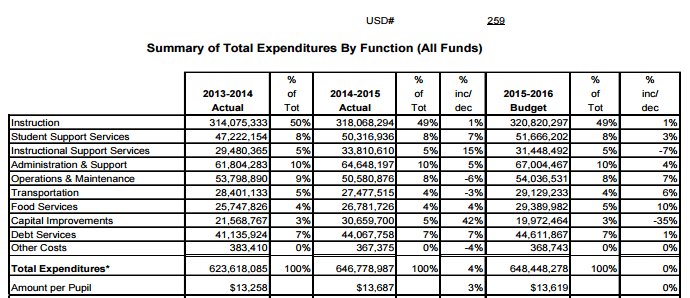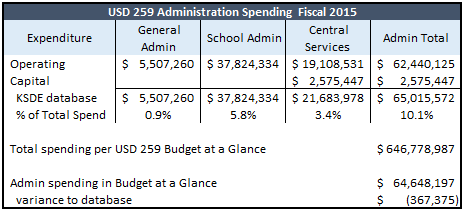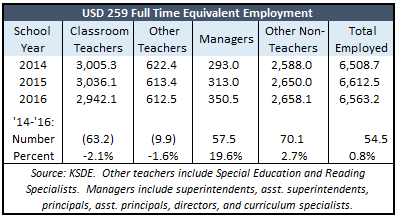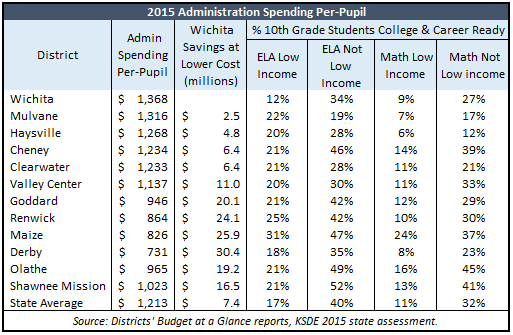KWCH-TV in Wichita may have intended to do a thorough examination of Wichita schools’ administration spending, but false information and failure to challenge district claims left viewers with the misleading impression that the district has done all it can to reduce administrative spending. Aside from brief comments by two legislators with opposing views, the story reads like a press release prepared by the district’s Communications Department, replete with tears and emotional lament. Readily-available information from the Kansas Department of Education and the district’s own reports tell a dramatically different story than the tale spun by USD 259 Superintendent John Allison.
We shared this article with KWCH prior to publishing, giving them the opportunity to correct their errors and share the realities of administration spending and hiring practices that refute claims made by USD 259. They said, “After thoroughly reviewing our story about school administration costs, we are making the following correction. Our story stated “general administration makes up just one percent (of the total budget). That includes his (superintendent) salary, district leadership like principals and other departmental directors.” This is incorrect. In our story, we put principals and other district leaders into the wrong category (general administration instead of school administration). As for the rest of the story, we stand behind its accuracy.”
They decided to correct only one of the three factual errors made in the story and declined to address the district’s own financial information that conflict with statements made about reducing administrative spending and getting money to classrooms. So we’ll do it for them.
KWCH: The first difficulty is just figuring out what administration actually is.
That’s not true. Administration spending is very clearly defined by the Kansas Department of Education Accounting Handbook. It is the total spent on General Administration (Function 2300), School Administration (Function 2400) and Central Services (Function 2500). The district’s Budget at a Glance report lists Administration at 10% of total spending for 2015-15.

KWCH: General Administration makes up just 1%. That includes…district leadership like principals and other departmental directors.
Again, not true (this is the one error KWCH says they will correct). General Administration is about 1% but that doesn’t include principals and other departmental directors. School administration (principals, assistant principals and other building-based manager are reported in School Administration, which accounted for another 5.8% last year. It’s unknown what was meant by ‘other departmental directors’ but they would not be included in the 1% of General Administration; some would be in Central Services (another 3.4% of Administration costs) and others would be in non-administration categories.[i]

KWCH: Business support services…account for 3.6%. And facility maintenance…makes up 7.2% of the district’s budget. Combined, that’s a total of nearly 12% the state considers administration.
Once again, that’s not true. As shown earlier, the state does not include Operations & Maintenance in Administration. But if they did, the total would be 18% instead of the 12% quoted. The difference is close to the amount of School Administration that was excluded from the stated amount of General Administration.
KWCH: “Why doesn’t the district cut administrative costs?” That was the first question we asked. “We absolutely are and have been every year,” said John Allison. “Our whole focus is on getting money to the classroom.”
USD 259 may have made some minor administrative reductions, but Allison hid the fact that Administrative spending is still on the rise. Their own Budget at a Glance shows spending increased from $61.8 million in 2014 to $64.6 million last year, and they budgeted $67 million this year. That $5.2 million increase over two years would be 8.4%.
The district’s own data also refutes the claim that the ‘whole focus’ is getting money to the classroom. Their Budget at a Glance report shows they only allocated 49% of spending to Instruction. District employment reports also refute their claim of focusing on the classroom.
 Full time equivalent enrollment increased 0.8% over the last two years, but the Wichita school board chose to eliminate 63 classroom teachers while adding 57 more managers and 70 other non-teachers. A large body of research shows that nothing makes more difference than effective teachers, so why, if the classroom is their focus, why would the Wichita school board eliminate teachers and add mangers?
Full time equivalent enrollment increased 0.8% over the last two years, but the Wichita school board chose to eliminate 63 classroom teachers while adding 57 more managers and 70 other non-teachers. A large body of research shows that nothing makes more difference than effective teachers, so why, if the classroom is their focus, why would the Wichita school board eliminate teachers and add mangers?
USD 259 spends more per-pupil on Administration than any other Sedgwick County district despite having the highest enrollment, which should give them an advantage on purchasing power and per-pupil allocations. The district says they need to reduce spending by $23 million next year and they could get it all out of Administration by matching the per-pupil administrative costs of Renwick, Maize or Derby, or nearly all by matching Goddard. And to show that large districts can operate at lower costs, Wichita could save $16.5 million matching the per-pupil spending of Shawnee Mission or $19.2 million by matching Olathe.
 Finally, excess spending on Administration cannot be explained away by academic outcomes. The majority of these districts have higher percentages of 10th grade students on track to be college and career ready on state assessments and with one exception, those with the lowest administrative spending have much better outcomes than Wichita.
Finally, excess spending on Administration cannot be explained away by academic outcomes. The majority of these districts have higher percentages of 10th grade students on track to be college and career ready on state assessments and with one exception, those with the lowest administrative spending have much better outcomes than Wichita.
Parents, teachers and others have good reason to question school board decisions to cut programs while choosing to overspend on administration and otherwise operate inefficiently. And they might have more respect for media if it consistently followed basic journalistic principles.
__________
[i] District online budget reports don’t provide breakouts of the three Administration categories, but that information can be found in the KSDE database. http://cpfs.ksde.org/custom_rpts.aspx There is an immaterial difference of 0.6% between district-reported spending in Budget at a Glance and the amount in the database, which is not uncommon.




